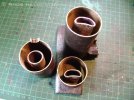DannyTheElfman
Registered
Hello again!
My apologies for starting another thread just a couple of days after my previous topic, I'm new to live steam so I have quite a few questions.
This one is regarding the safety valve and it's operation in my Accucraft Edrig. Basically, I was expecting for the boiler to reach 55-60psi and the safety valve to sort of "pop" open. But this doesn't really happen. Instead, At about 25psi the safety valve starts to release just a little of steam, at 30psi a little more steam leaks out, and at 35psi a little more, and so on and so forth until about 60psi. So instead of that single pop I was expecting, it's a gradual increase between 25 and 60psi. I could not identify a one single moment when the valve went from closed to open.
Is this correct operation? It does it's job, the pressure never goes over 60psi. But it seems like this wastes a lot of steam when it doesn't need to be?
Many thanks
Dan
My apologies for starting another thread just a couple of days after my previous topic, I'm new to live steam so I have quite a few questions.
This one is regarding the safety valve and it's operation in my Accucraft Edrig. Basically, I was expecting for the boiler to reach 55-60psi and the safety valve to sort of "pop" open. But this doesn't really happen. Instead, At about 25psi the safety valve starts to release just a little of steam, at 30psi a little more steam leaks out, and at 35psi a little more, and so on and so forth until about 60psi. So instead of that single pop I was expecting, it's a gradual increase between 25 and 60psi. I could not identify a one single moment when the valve went from closed to open.
Is this correct operation? It does it's job, the pressure never goes over 60psi. But it seems like this wastes a lot of steam when it doesn't need to be?
Many thanks
Dan

